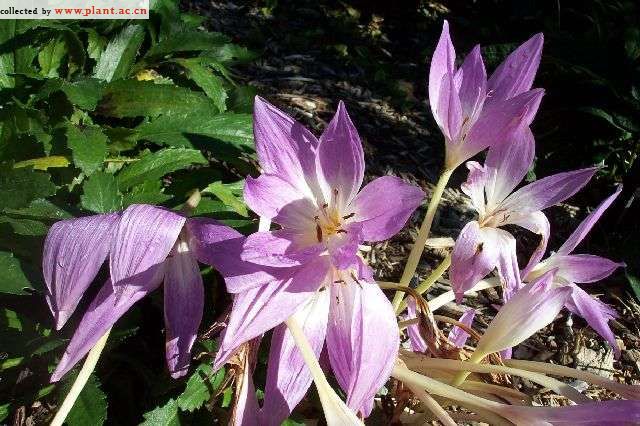Colchicum autumnale PleniflorumAutumn crocus
Family:Colchicaceae
common name:Autumn crocus
introduce:Plant Type: Bulb
Family: Colchicaceae
Missouri Native: No
Native Range: None
Height: 0.25 to 0.5 feet
Spread: 0.25 to 0.5 feet
Bloom Time: August - September
Bloom Color: Rose-pink (double)
Sun: Full sun to part shade
Water: Medium moisture
Maintenance: Medium
General Culture:
Easily grown in average, medium wet, well-drained soils in full sun to part shade. Plant corms 3?deep and 6?apart in August for bloom the same year in fall. If necessary, dig and divide during the mid-summer dormant period.
Noteworthy Characteristics:
Autumn crocus is so named because it blooms in fall, although this species is one of the earliest of the colchiums to bloom, often appearing as early as late August. In late spring, plants send up somewhat unattractive foliage (4-6 lance-shaped, dark green leaves to 14?long). Foliage gradually yellows and dies by summer as the plants go dormant. Naked flower stems rise from the ground to 4-6?tall in late summer to early fall bearing goblet-shaped flowers (to 3?long). Species flowers are purple to pink to lilac. 慞leniflorum?features rose-pink double flowers. 慞leniflorum?is synonymous with 慞lenum?and 慠oseum Plenum? This species is also sometimes commonly called meadow saffron. The drug colchicine is extracted from the seeds and corms of this species for medical use in the treatment of gout and for horticultural use in the hybridization of plants and chromosome doubling. Spring crocus is in the iris family, but autumn crocus is either placed in the lily family or in its own family (Colchicaceae). Autumn crocus is not closely related to the source of commercial, edible saffron (Crocus sativus) which is a fall-flowering, true crocus closely related to the common spring-flowering crocuses.
Problems:
No serious insect or disease problems. Watch for slugs and snails. Botrytis is an occasional disease problem. Corm rot is a concern in poorly-drained wet soils. Weak flower stems tend to flop.
Uses:
Meadows, woodlands, beds. Good for pockets in the landscape where spring and summer plants are fading. Good around patios or along walks. Plant with low ground covers that may help support weak flower stems. Generally inappropriate for prominent parts of beds or borders because of the unsightly appearance of the spring foliage as it yellows and declines on its way toward summer dormancy.
